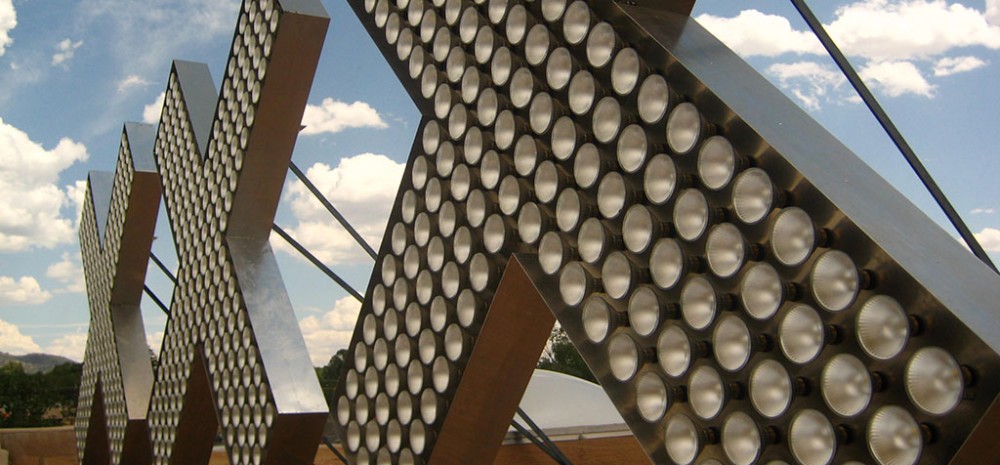Born in 1968 in London, England
Lives and works in New York City
Nadine Robinson
Tri-Christus, 2008
I am an artist who incorporates various mediums and materials with traditional modernist and post-modernists strategies to explore social phenomenon (such as religion, sexuality, classicism), popular urban cultures (music, cinema) and historical fictions/non-fictions (racism, historicism). That is, I create objects, events, or installations that are conglomerates of ideas, which are specific to my personal narrative but also identifiable as world narrative. Simultaneously, my work is an attempt at fusing defunct philosophical inquiries on existence, such as metaphysics (the unreal), with the practicalities and materials of working-class urbanism (the real).
This project can be illustrated in many of my art works, for example, the task of expressing portraiture and identity using the artifice of synthetic hair (Laquita, 2005), or I may discuss social injustices and race by employing abstractions of architecture and music (Tower Hollers, 2002 and Das Rattenfangerhaus, 2001).
The pessimism of the premise of a malevolent universe (see Ayn Rand) is apparent in most of my recent work (alles grau en grau malen, 2005 and Wormwood, 2005) as I struggle to locate myself in contemporary artistic practices and participate in critical dialogue about race, religion, capitalism, media and modernism. These explorations, as aesthetically seductive as they may be, hold the possibility of encouraging certain death but also give us an opportunity to hope (Rockbox, Version One, 2006).
Although these works appear edifying because of the vast amount of research, which informs them, they are open-ended. They offer the possibility of changing one’s mind view and shaping the world (and saving or sacrificing oneself) through the creation of new experiences and pseudo-phenomena, to build bridges between people and ideas, between materials and the body, between hope and despair.
Tri- Christus continues this task of creating works of art and installations that stimulate expressions of individual psychological identity and the social self, or group psychological identity (our mirror of the universe), while exploring the interstices of painting, sculpture, sound light, and architecture. The religious symbol of the cross continues my exploration into the complexities of organized (for example Catholicism and Protestantism), and non-organized religion, (Obeah, Santeria, and Rastafarianism), and cultural interpretations of the individuals’ spiritual belief system as experiences as practiced within Western European-based society. Tri-Christus takes the physical form of three platonic Greek crosses. Each of the four arms of the Greek cross are equal in length, and equate to the four corners of the earth  North, South, East and West. It is also three “Chi’s†or Greek initials for the Name of Christ. Tri-Christus, the brilliantly lit roadway sign, the Sign of Christ, representing the evangelizing throughout the world by the Christ’s Apostles, is the physical movement of the hand between head, lips and shoulders, used to unify Christians in public worship, exorcise demons, and cure diseases. Presented three times it is most common in the secular world as a warning of written or visual explicit sexual and violent content for the sole purpose of inducing sexual pleasure. It is also the title of a contemporary action film and its sequel, it is the Roman number thirty, and it depicts illegal alcoholic beverage, as well as many other things.
Tri-Christus in its location on the roof of SITE Santa Fe is an invitation to consider this complex and somewhat confrontational symbol, as a warning of the many possibilities of its intentions, as an evangelical directive, and as potential force on the works of art installed under its signage. It’s raw aluminum fixture of over 600 commercial light bulbs reminds us of sci-fi set constructions in New Mexico’s booming film industry. It challenges the stars in heaven, lighting up the night sky of the City of Holy Faith, offering all of us the opportunity to be saved, dammed, or potentially worse, ignored.
Nadine Robinson’s installation is located above the front entrance on the roof of SITE.
Nadine Robinson’s story is a quintessentially American one. Born in London to Jamaican parents, Robinson spent her childhood in Kingston, Jamaica; she later immigrated to New York in 1975, eventually settling in the Bronx. A conceptual artist working predominantly in light and sound, Robinson’s work is both a reflection of her cultural hybridity, and the result of her critical engagement with notions of blackness, urbanism, spirituality, and the legacy of the male-dominated, white modernist canon.
Robinson has become well-known for her large-scale sculptures and “sonic paintings†that appropriate the abstraction, purity, and rigid geometry of minimalist artists Robert Ryman and Ad Reinhardt, yet contain narratives culled from a variety of sources ranging from biblical verses and German fables, to samples of hip hop music and spiritual chants drawn from Jamaican mysticism.
Tower Hollers (Version I), or 455 “boom paintings,†which was conceived during her residency at the World Trade Center Studios in 2001, is emblematic of the visual and aural contrasts that underscore Robinson’s artistic practice. She installed a grid of 12-inch by 12-inch squares of white canvas stretched over traditional painting frames on the wall. Consisting of 455 speakers – each embedded in panels of varying sizes – the piece played abstract elevator “muzak†and remixed Negro work songs, creating a choral wall made of improvised, impassioned protest songs melded with vacuous, synthetically produced sounds.
Robinson fuses materials ranging from DJ equipment and hair extensions to found recordings of Pentecostal readings together. She blends high art and street culture, the formal purity of abstraction with narrative expressions, and the fervent extremism of religious spirituality with the vernacular of hip hop culture. Her art physically embodies the tensions that exist between races, cultures, classes, and religious ideologies that are not only characteristic of America’s cultural past, but remain endemic to its present.
Laura Heon
